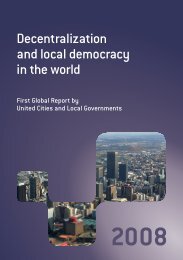Making Cities Resilient Report 2012
Making Cities Resilient Report 2012
Making Cities Resilient Report 2012
Create successful ePaper yourself
Turn your PDF publications into a flip-book with our unique Google optimized e-Paper software.
CHAPTER 3 | Key Trends on Resilience-Building in <strong>Cities</strong><br />
Box 3.1 : Community engagement and dencentralisation in San Francisco,<br />
Cebu, Philippines<br />
San Francisco is a small island municipality within the Camotes Island group, which is part of the province<br />
of Cebu. It consists of 15 barangays (12 are coastal), which cover a total of 10,597ha. The municipality has<br />
a total low-density population of 48,834 (2007). The town has received numerous awards and international<br />
accolades for its work in DRR and resilience. The former Mayor and current Vice Mayor, Alfredo Arquillano,<br />
cites this success to a youth and community –centered engagement approach, which integrates DRR into<br />
environmental and social development programmes, which prioritise selected resilience targets that are<br />
practical and tangible in the eyes of the local community. These include solid waste management, tree<br />
planting, mangrove rehabilitation and integrated farming. Children and youth are engaged in all aspects of<br />
resilience building. For example, student leaders participate in local government decision making through<br />
the Local Disaster Coordinating Council (LDCC). There are child-led risk assessments and an early warning<br />
system, and children participate in community drills and simulation exercises. Out-of-school youth have<br />
participated in training exercises on search and rescue, emergency response and swimming. Together,<br />
these approaches aim to address disaster risk, social vulnerability and environmental sustainability in a<br />
mutually reinforcing way.<br />
Resilience building has also been aided by a decentralized governance system. Since 2004, Puroks,<br />
the community group structure below the village-level Barangays, consisting of between 40 and 100<br />
households, each have an elected President who leads a monthly community meeting. The regularity<br />
of these meetings ensures on-going community consultation and continuous education about current<br />
risks and community activities. Participation and commitment are incentivized through cash awards<br />
available to high-achieving Puroks that deliver on their key objectives (which include meeting regularly<br />
and complying with guidelines around segregated waste and maintaining backyard gardens). They are<br />
encouraged to use this capital either as reinvestment, to establish micro-finance lending systems to<br />
stimulate and support the local economy, or as savings in case of emergencies. The Purok system has<br />
been important in mobilizing and empowering communities by connecting them into a wider model of<br />
participatory governance. The system undergoes regular evaluation to ensure continuous improvement,<br />
using indicators developed to measure success.<br />
Another characteristic of early resilience building in some low-capacity contexts is activities driven<br />
by central government supported by multi-lateral agencies, rather than from within city or municipal<br />
governments themselves. In both Pakistan and Rwanda, early resilience building is initiated through a topdown<br />
process in association with UNISDR and UN-Habitat. This may be a reflection of the current weakness<br />
of local government authorities in these countries, and the low capacity of national government, which<br />
require support and resources from outside agencies. The evident commitment to risk reduction from<br />
national government in these cases will hopefully facilitate resilience building at municipal level, by<br />
decentralising resources and providing a supportive legislative framework.<br />
The main advantage, in terms of resilience, of an<br />
urban context that enjoys a higher level of socioeconomic<br />
development is the availability of more<br />
resources and funding for complex hazard management,<br />
forecasting and early warning systems. Venice,<br />
for example, has a high level of socio-economic<br />
development and a sophisticated hazard mitigation<br />
system: the MOSE system (Box 3.2).<br />
“Changing attitudes and behaviours is a<br />
tough undertaking, but I never give up. It’s<br />
necessary to start small and with those<br />
who are willing. You have to show people<br />
actions with high impact, and then they<br />
will join the effort and become organised.<br />
It took me five years to accomplish that.”<br />
Alfredo Arquillano, Vice Mayor,<br />
San Francisco, Philippines<br />
<strong>Making</strong> <strong>Cities</strong> <strong>Resilient</strong> <strong>Report</strong> <strong>2012</strong> | 35

















